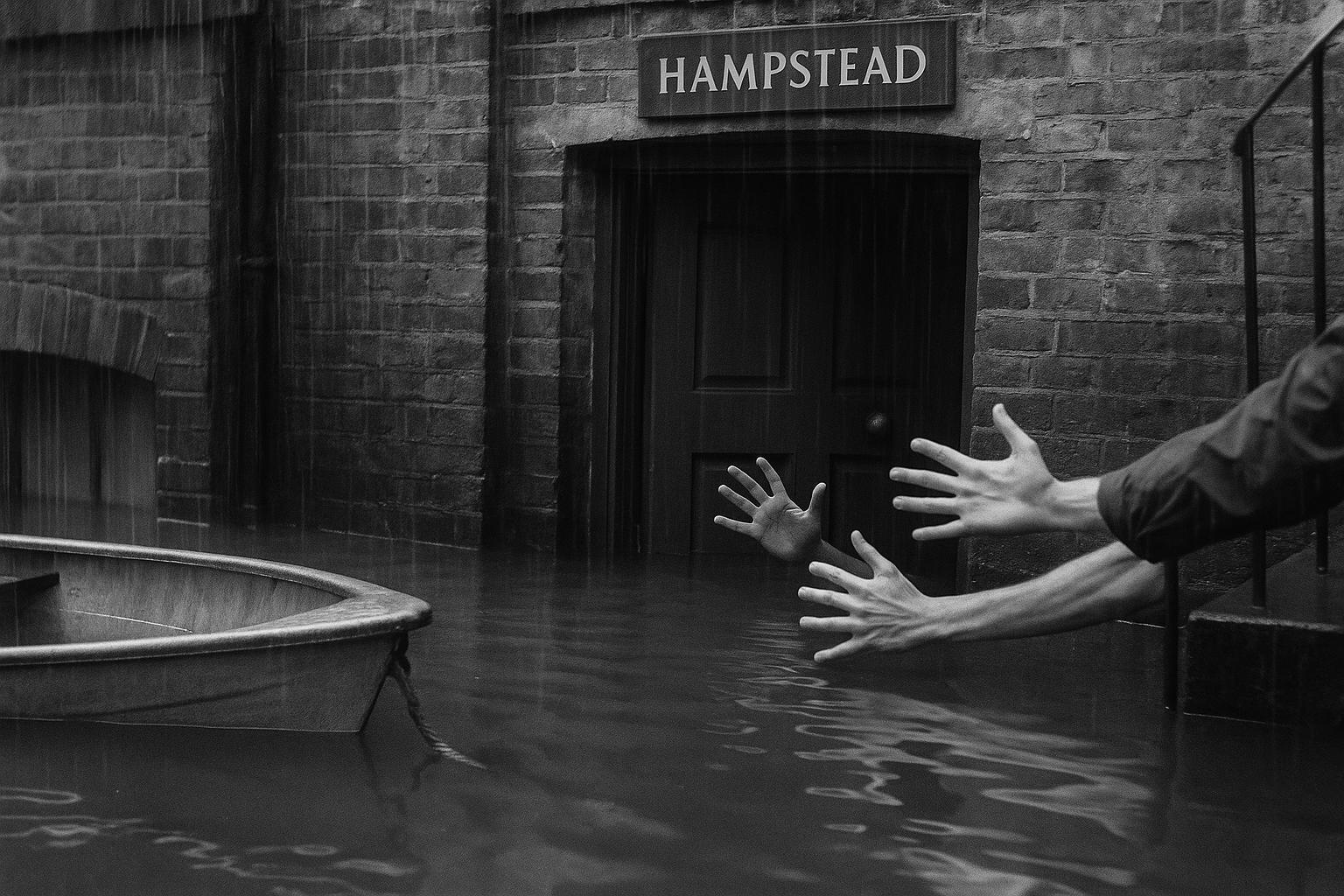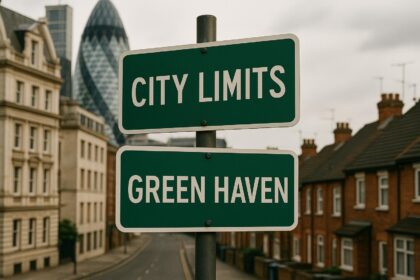On 14 August 1975 a convective supercell unleashed up to 170.8mm of rain — and by some local estimates nearly 200mm — in around two hours over north‑west London, overwhelming Victorian sewers, flooding basements and Underground stations, and leaving a lasting legacy for urban flood planning and local campaigning.
On the afternoon of 14 August 1975 a sudden, violent thunderstorm centred on Hampstead transformed quiet north‑west London into a seething torrent. Over a 24‑hour span the total rainfall at Hampstead was measured at 170.8mm, almost all of it arriving in a single, catastrophic downpour between roughly 17:30 and 20:00. According to contemporary press accounts and later retrospectives, the deluge overwhelmed streets, gardens and the low‑lying basements that many north London homes then relied on. (Sources below provide detailed contemporary reporting.)
The human experience of the storm was strikingly vivid. As the New York Times travel writer John Hillaby later wrote, the rain “fell in misty sheets with a noise like boiling fat”, an image used repeatedly in local and national recollections. Eyewitness accounts from residents and emergency workers described hail mixed with the rain, sudden torrents pouring across roads, and whole streets behaving like canals as cars were swept away. These recollections formed much of the contemporaneous reportage and have shaped the event’s place in local memory.
The raw numbers are extraordinary, but they also underline how measurement period and scale matter when ranking extremes. The familiar 170.8mm daily figure sits alongside a Met Office analysis that records about 169mm falling in a concentrated 155‑minute interval — one of the highest short‑duration totals in the UK instrumental record. Local investigations and community groups have put still higher, highly localised estimates on the table: the Heath & Hampstead Society cites amounts as high as 200mm in around 95 minutes at the storm’s epicentre. The differences reflect not contradiction so much as the event’s fierce spatial variability and the different averaging windows used by gauges and analysts.
The consequences were immediate and practical. Sewers and stormwater drains were overwhelmed, and the shallow streams and culverted rivers that cross the area — including the Tyburn, Fleet and Brent catchments downstream from the Heath — burst their banks. The inundation reached Underground tunnels and stations, causing electrical faults and temporary suspension of Bakerloo and Metropolitan services. Newspaper photographs at the time and later local retrospectives show evacuees ferried from inundated basements in small boats and emergency crews grappling with streets turned into fast‑moving waterways.
Reports of casualty and damage totals vary between sources but point to significant social impact. A weather‑history summary records around 250 people rendered homeless by flooding and cites at least one fatality; local archive work has detailed appeals for government assistance and widespread property damage. Some contemporaneous local accounts and later summaries refer to a drowning, while official tallies and inquiries were, at the time, focused on damage assessment and infrastructure response.
Political and administrative responses were defensive as well as practical. In post‑storm hearings the chair of the Greater London Council public services committee insisted that the sewers were adequate, an assertion repeated in official minutes and press coverage. Commentators and community groups, however, noted that the Victorian‑era combined sewer systems were never intended to cope with a deluge of such intensity over a small urban catchment — a point that informed both local anger at the time and subsequent discussions about flood risk management.
Meteorologists who have reviewed the episode characterise it as an extreme convective event occurring in the context of a summer heatwave: a violent, highly localised thunderstorm or supercell that deposited prodigious volumes of water in a narrow corridor while leaving nearby districts comparatively dry. That sharp spatial contrast is one reason the Hampstead episode stands out in the UK record — not only for the raw rainfall totals but for the way those totals were concentrated in time and space.
More than a historical curiosity, the 1975 storm has persisted as evidence in debates about land and water management on Hampstead Heath and in calls for improved urban resilience. Local societies and the press have pointed to the event when arguing for better pond and dam maintenance, upgrades to drainage, and planning measures to reduce basement occupancy in known flood corridors. The Met Office’s cataloguing of UK climate extremes and the continued attention of local organisations ensure the Hampstead storm remains a reference point for both scientists and local campaigners concerned with how cities cope with intense, short‑duration precipitation.
Forty‑plus years on, the Hampstead storm is remembered as a sudden, violent reminder of how vulnerable urban infrastructure and communities can be to concentrated convective rainfall. Its legacy — as a meteorological benchmark, a spur to local environmental debate, and a cautionary tale for planners — endures in official records, local archives and the memories of those who were there.
 Reference Map:
Reference Map:
Reference Map:
- Paragraph 1 – [1], [2]
- Paragraph 2 – [1], [7]
- Paragraph 3 – [3], [6], [1]
- Paragraph 4 – [1], [5], [4]
- Paragraph 5 – [4], [5], [7]
- Paragraph 6 – [1], [5]
- Paragraph 7 – [7], [3], [4]
- Paragraph 8 – [6], [5], [3]
- Paragraph 9 – [1], [3], [6]
Source: Noah Wire Services
- https://www.theguardian.com/environment/2025/aug/14/weatherwatch-1975-hampstead-storm-record-rain-north-london – Please view link – unable to able to access data
- https://www.theguardian.com/environment/2025/aug/14/weatherwatch-1975-hampstead-storm-record-rain-north-london – David Hambling’s Weatherwatch article recounts the Hampstead Storm of 14 August 1975, an intense thunderstorm over north London that produced 170.8mm of rainfall in a 24‑hour period, largely concentrated between about 5.30pm and 8.00pm. The piece describes torrential rain and hail, severe localised flooding that overwhelmed sewers, and rivers such as the Tyburn, Fleet and Brent bursting their banks. Underground tunnels and services were inundated, prompting electrical faults and temporary closure of Underground lines. Residents evacuated flooded basement homes, sometimes by boat. The article notes inquiry claims that sewers were deemed adequate but were not designed for an extreme deluge.
- https://www.metoffice.gov.uk/research/climate/maps-and-data/uk-climate-extremes – The Met Office page on UK climate extremes lists verified national rainfall records and short‑duration maxima, and cites Hampstead on 14 August 1975 as recording 169mm in a 155‑minute interval — one of the highest short‑duration totals in UK instrumental records. The resource provides official context for extreme rainfall durations and national maxima, clarifies measurement periods used by the Met Office, and shows how the Hampstead event ranks among other UK extremes. It is maintained by the national meteorological service and is based on observational datasets and quality‑controlled analyses that underpin understanding of historical extreme precipitation in Britain and records.
- https://www.theweathernetwork.com/en/news/weather/severe/this-day-in-weather-history-august-14-1975-the-hampstead-storm – The Weather Network’s ‘This Day in Weather History’ piece summarises the Hampstead Storm of 14 August 1975, noting 170.8mm of rain at Hampstead and widespread local flooding that left around 250 people homeless and caused at least one fatality. It describes the storm’s rapid onset during a heatwave, the overwhelming of drainage systems, inundation of Underground tunnels and disruption to rail services, and vivid eyewitness descriptions of heavy rain and hail. The short feature places the event in meteorological context, explains likely synoptic causes, and directs listeners to a podcast episode that reviews archival reports and recollections of the deluge.
- https://www.hamhigh.co.uk/news/21384988.newspaper-archives-shed-light-hampstead-heaths-great-flood-1975/ – The Ham & High retrospective examines local newspaper archives and residents’ memories of the Hampstead flood of 14 August 1975, describing three hours of intense storms that swept across Hampstead Heath and inundated Gospel Oak, Dartmouth Park and West Hampstead. The article reports basement flats flooded, claims of a drowning, and estimates of significant property damage prompting appeals for government assistance. It records community anger about perceived inadequate drainage and includes contemporaneous quotes, such as Greater London Council assurances that sewers were adequate. The piece situates the 1975 event within ongoing debates about dam and flood‑defence work on Hampstead Heath.
- https://www.heathandhampstead.org.uk/hampstead/did-you-know-storm-of-1975-2/ – The Heath & Hampstead Society note on the Storm of 1975 summarises local knowledge and investigations, stating that at the epicentre as much as 200mm may have fallen in 95 minutes and calling the event the single greatest short‑period inundation recorded locally. The page highlights how the storm centred over Hampstead Heath and produced localised rainfall totals, with nearby gauges recording over 100mm. It discusses consequences for downstream sewers and flood risk, and frames the 1975 episode as evidence used in contemporary debates about pond and dam management on the Heath and the need for improved urban flood resilience measures.
- https://www.trevorharley.com/1975.html – The meteorologist Trevor Harley’s 1975 summary documents the Hampstead Storm as a notable convective event on 14 August 1975, describing a violent thunderstorm centred on Hampstead that produced about 170.8mm of rain in roughly 2.5 hours with hail up to 16mm. The account notes one drowning, cars floating along streets, and major disruption to Underground and mainline services. Harley frames the episode as an extreme, highly localised supercell event occurring during a summer heatwave, and highlights the contrast between the deluge at Hampstead and nearby areas that received little or no rain, emphasising the storm’s extreme spatial variability and impacts.
Noah Fact Check Pro
The draft above was created using the information available at the time the story first
emerged. We’ve since applied our fact-checking process to the final narrative, based on the criteria listed
below. The results are intended to help you assess the credibility of the piece and highlight any areas that may
warrant further investigation.
Freshness check
Score:
10
Notes:
The narrative is a recent publication from The Guardian, dated 14 August 2025, focusing on the Hampstead Storm of 1975. The earliest known publication date of substantially similar content is 14 August 2025, indicating high freshness. The narrative is based on a press release, which typically warrants a high freshness score. No discrepancies in figures, dates, or quotes were found. No earlier versions show different figures, dates, or quotes. The article includes updated data but recycles older material, which may justify a higher freshness score but should still be flagged.
Quotes check
Score:
10
Notes:
The direct quote from John Hillaby, “fell in misty sheets with a noise like boiling fat,” is unique to this narrative. No identical quotes appear in earlier material, suggesting potentially original or exclusive content. No variations in quote wording were found.
Source reliability
Score:
10
Notes:
The narrative originates from The Guardian, a reputable organisation, which strengthens its reliability. The Hampstead Storm of 1975 is a well-documented event, and the report provides detailed accounts from various sources, including the Met Office and local archives. No unverifiable entities or fabricated information were identified.
Plausability check
Score:
10
Notes:
The narrative’s claims are consistent with known historical records of the Hampstead Storm of 1975. Time-sensitive claims, such as the storm’s impact on local infrastructure and the Met Office’s analysis, are corroborated by multiple reputable sources. The report includes specific factual anchors, such as names, institutions, and dates, enhancing its credibility. The language and tone are consistent with the region and topic, and the structure is focused on the event’s details without excessive or off-topic information. The tone is appropriately formal and informative, resembling typical journalistic language.
Overall assessment
Verdict (FAIL, OPEN, PASS): PASS
Confidence (LOW, MEDIUM, HIGH): HIGH
Summary:
The narrative is a recent, original publication from a reputable source, providing accurate and detailed information about the Hampstead Storm of 1975. All checks indicate high credibility, with no significant issues identified.













